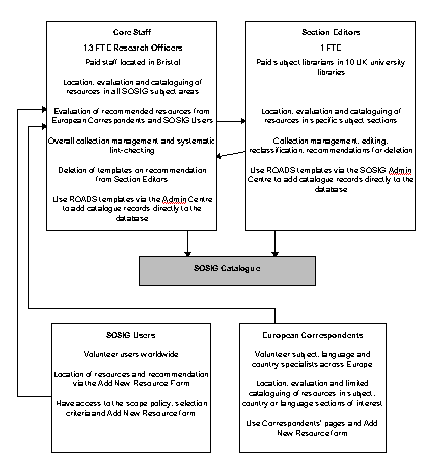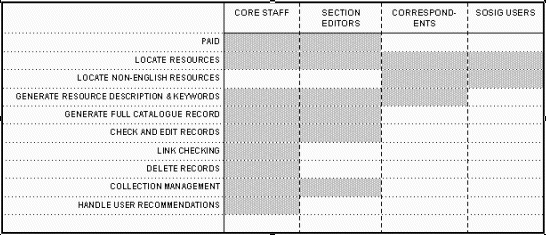| Search | Help |
|
|
||||
|
||||
|
Introduction
|
|
|
This chapter introduces the concept of distributed cataloguing and the potential for working collaboratively across the Internet. It looks at some of the human issues involved in distributing cataloguing effort, presents some models currently in use within information gateways and in particular looks at the experiences of SOSIG in employing a distributed model. Some further examples of distributed cataloguing models are also presented. Because of the open nature of the Web there is considerable potential for distributed collaborative cataloguing of networked resources. Information gateways can be built by teams of staff who are geographically dispersed but who can add resources to a database from their desktops via the WWW. This chapter concentrates mainly on issues surrounding distributed cataloguing into a central database. However, an additional or even complementary model is that of collaborative work with other gateways (see the chapter on co-operation for more details). Why would an information gateway want to consider distributed cataloguing? Distributing the cataloguing effort allows you potentially to share the responsibility with a number of organisations or participants and to maximise the coverage of the collection. In particular it allows gateways to:
|
|
|
Models for distributed cataloguing
|
|
|
There are numerous cataloguing models currently being employed by information gateways. The main contrast is that of the use of paid versus voluntary effort. However, even within this broad division there are several approaches, e.g.:
And within these organisational setups there are various ways of assigning roles and responsibilities. These range from allowing members of the team to have full responsibilities and access to the database to a very defined division of labour between selecting, evaluating and cataloguing resources. DESIRE 1 held a training workshop on the Distributed Cataloguing Model in 1997, which brought together staff from a number of European information gateways to share experiences of their models and the tools, training materials and methods of delivery to support them. A report summarising the outcome of the workshop can be found at: http://www.desire.org/results/training/D8-2af.html |
|
|
Management issues
|
|
|
There are a number of issues to consider when setting up a distributed cataloguing system. Recruitment One of the most crucial issues for gateways is recruiting the right staff to work on the catalogue. The core skills of resource selection and cataloguing make librarians ideally placed to assume the role, as they have the training and the expertise required. However, academic subject experts or others with the appropriate subject knowledge may also be valuable. It is also important to bear in mind that as well as subject knowledge a fair degree of expertise in use of the Internet is also necessary and that these two skills are not always found together. As well as deciding on the type of person required, gateways will also need to consider the best approach to finding and recruiting these people. Putting out a general call for staff will usually result in receiving replies from enthusiastic individuals who are keen to do this sort of work. However, they may have difficulties in getting the support they need to do this from their institution or place of work. Conversely, going through the institution will ensure commitment from the top down but may not result in the ideal candidates being selected from within the institution. A key decision is whether the staff will be volunteers, will include the work as part of their jobs or be paid for their contributions. Paid staff will enable gateways to set and work to targets allowing for the development of the gateway to planned and monitored. With voluntary effort gateways are relying on the goodwill of the people concerned and the ability to fit these duties around their main jobs and activities. It is quite possible that there will be very little return for the considerable investment made in training and development. Perhaps the ideal situation is to have staff who are supported by their institutions to incorporate the role into their day-to-day work. Ensuring that paid staff have protected time to carry out their gateway duties may also be an issue; it is possible that external staff have been given this additional role on top of their existing work and will find it difficult to cope with both. Good communication between the central and distributed staff can help to prevent these problems arising.
Support tools and mechanisms Gateways need to develop a system for staff to be able to remotely recommend or catalogue into the system. Again, various methods are used by gateways; these range from emailing details of resources to central staff to Web based cataloguing systems such as ROADS. Training Training staff to contribute to the gateway is essential. They will require training in:
Ideally this training would take place as a face-to-face workshop, although, given the possibility of contributors being located around the world, training could also take place through distance learning via email and the Web. Documentation Whether training is conducted remotely or face-to-face, extensive documentation is required to support the work of the staff. Various approaches are being used by existing gateways. Some have printed handbooks with all the information required; others have set up administration centres on the Web with online documentation and support. Monitoring and support Perhaps one of the greatest drawbacks of running a distributed team is dealing with the problems of working remotely. The job requires that staff should be self-motivated, yet it is very easy for staff to feel isolated without the advice and support of colleagues around them. A geographically dispersed team will rely heavily on remote communication through one-to-one email contact, use of mailing lists and Web conferencing systems for 'virtual meetings'. |
|
|
A case study: SOSIG
|
||||
|
SOSIG has successfully employed a distributed team of subject experts (known as Section Editors) for the past two years. Subject librarians from ten UK universities were appointed to select, evaluate and catalogue resources for the SOSIG catalogue. Each Section Editor is given responsibility for developing a subject area on the gateway. In some cases the Section Editors' roles are shared between two or more people at an institution, but total effort does not exceed more than one day per week. A one-day workshop was held at the start of the project to train the staff on all aspects of working on an information gateway. This included:
Prior to the workshop an online administration centre was set up, which included all the tools and guidelines required to catalogue resources for the gateway. After the workshop, additional support was offered through email contact with the core staff. This one-to-one contact was initially very important as the Section Editors had a very steep learning curve to ascend. The geographical distances between the staff meant that they were very reliant on email as a means of virtual support and assistance. As the Section Editors have direct access to the live database to begin with, all of the work submitted had to be checked centrally and any errors corrected and/or reported back to the appropriate Editor. This put a very high overhead on central effort for the first few months of the scheme; however, this requirement diminished gradually and now only random checks are made on the records. In addition to the Section Editors, SOSIG also has a number of European Correspondents. Correspondents are academics or librarians who have volunteered to submit new resources on an informal but regular basis. Correspondents have access to online training and support materials but they do not catalogue directly into the database; rather they are responsible for selecting resources and submitting the suggestions to the central team through an online form. The responsibilities and duties for the gateway can be represented visually in two ways:  Figure 1: Workflow  Figure 2: Tasks and responsibilities There have been various general lessons learnt in the process of establishing this distributed approach as a result of other attempts by SOSIG to encourage distributed input, which may be relevant to other gateways. These are:
|
||||
|
Recommendations
|
|
|
There is great potential for distributed cataloguing systems, as they open up the possibility of national or international strategies. They also provide a successful model for involving the library community in Internet resource discovery. Existing gateways have invested effort in developing systems that support the work of distributed teams, so that a librarian can work on a gateway from anywhere in the world as long as they have access to a networked PC and a Web browser. Distributed Internet cataloguing means that libraries can contribute to a shared service, rather than having each to build a local service. This is an efficient way of working, as it avoids duplicated effort and collaboration allows large-scale gateways with much better coverage to be developed. Building and managing distributed teams is a challenge; there are a number of issues that need to be dealt with. In summary, some of these are:
|
|
|
Glossary
|
|
|
ADAM - Art, Design, Architecture and Media gateway |
|
| References
|
|
|
DutchESS Manual: handleiding voor vakspecialisten, http://www.konbib.nl/dutchess/manual/ EELS Project, http://www.ub2.lu.se/eel/about.html EEVL, http://www.eevl.ac.uk/volunt.html Friends of ADAM, http://www.adam.ac.uk/friends/ Länkskafferiet (Link Larder), http://lankskafferiet.skolverket.se/information/brief_presentation.html SOSIG Correspondents Pages, http://www.sosig.ac.uk/desire/ecorresp.html T. Hooper, L. Huxley & P. Hollands, DESIRE: Subject-based training materials L. Huxley, 'DESIRE on Planet SOSIG: Training for the Distributed Internet Cataloguing Model', Ariadne 12 (1997). E. Worsfold, 'Distributed and Part-Automated Cataloguing: A DESIRE Issues Paper' (March 1998). |
|
| Credits
|
|
|
Chapter author: Debra Hiom |
|
| << P R E V I O U S | 1 | 2 | 3 | 4 | 5 | 6 | 7 | 8 | 9 | 10 | 11 | 12 | 13 | N E X T >> |
| Go to the table of contents |
| Return to: Handbook Home DESIRE Home |
Search | Full Glossary | All References Last updated : 20 April 00 |
Contact Us © 1999-2000 DESIRE |